11-Drive DRAMless SSD Round Up
128GB Benchmark Results
Why you can trust Tom's Hardware
Product Comparisons
We only include DRAMless models in our performance breakouts. This is a special class of products that falls outside of traditional SSDs, and in the future, we will see more products in the DRAMless category. I would certainly hope not, but the push to create lower cost SSDs brings about some interesting products. Just like the transition to NVMe, DRAMless SSDs will grow and eventually most entry-level SATA products will ship without DRAM.
We have three separate controllers in the 120GB-class, though two of the SSDs are paired with roughly the same NAND. Toshiba (OCZ) and SanDisk produce NAND in the joint Flash Forward venture. Each company takes possession of the finished wafers, but there are some subtle processing differences. The companies may cut the die differently and use a different process to bin or sort by quality. Controller programming is different for each of the three products. The OCZ TL100 uses an in-house Toshiba controller. SanDisk tapped SMI for the DRAMless drives, but the SSD Plus 120GB uses the older SM2246XT controller with 15nm MLC. The Z410 uses the new SM2256XT controller but pairs it with 15nm TLC.
Sequential Read Performance
To read about our storage tests in-depth, please check out How We Test HDDs And SSDs. We cover four-corner testing on page six of our How We Test guide.

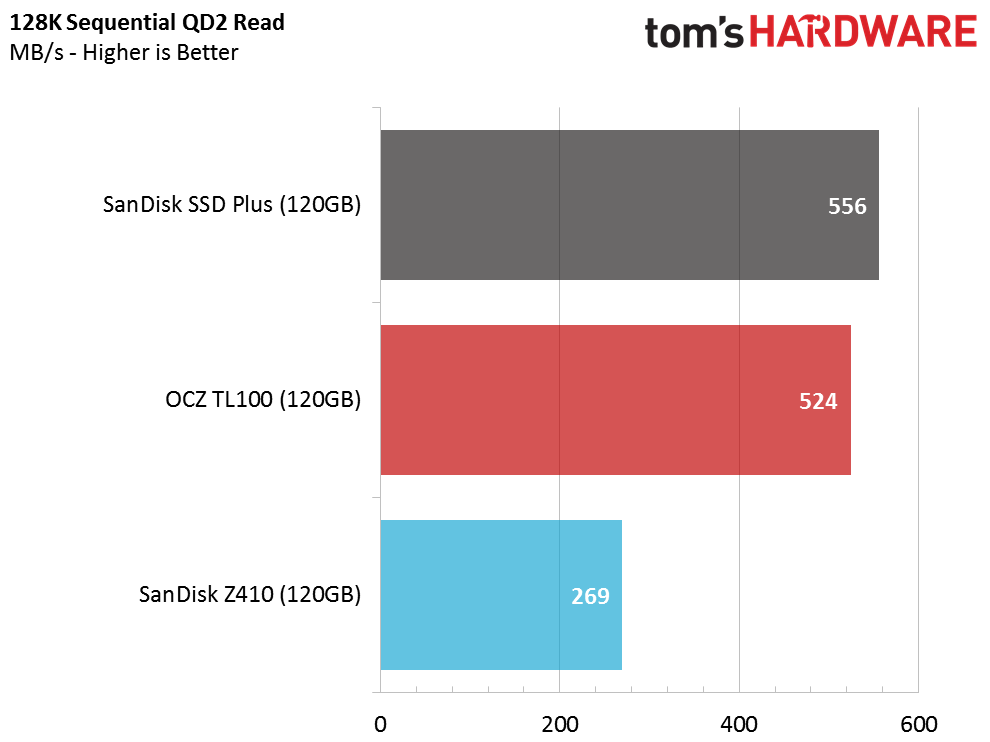
It shouldn't shock anyone that the SanDisk SSD Plus outperforms the two TLC-based products in many of the tests. The SLC buffer in the TLC products will outperform the MLC-based SSD Plus in some tests, but it only operates at full speed for a few seconds. The sequential read test shows that the two-package MLC drive still delivers higher performance when you request data back from the drive.
Sequential Write Performance


The MLC flash in the SanDisk SSD Plus 120GB doesn't lose performance as fast as the TLC drives. Testing DRAMless SSDs is difficult due to the rapid write performance decline and how low the performance drops. We stopped reviewing 128GB-class products over a year ago. 256GB-class products often cost only a few more dollars, so 128GB-class SSDs aren't a good value.
The wave in the test results is due to the SLC buffer filling and emptying. We can't control at which point in the test the buffer ebbs and flows. High-capacity SSDs are more predictable because the buffer is larger, but the low capacity SSDs have a much smaller buffer so the user experience is less enjoyable.
Sustained Sequential Write

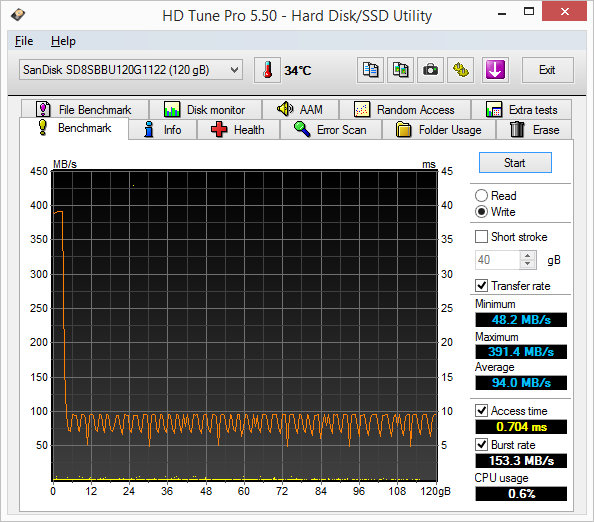

We were surprised to see the OCZ TL100's high performance in the HD Tune Pro sequential write test. Performance should have dropped, but it didn't on the first pass. The SSD Plus didn't drop either, but its MLC flash could only muster a 210 MB/s sustained write speed. The Z410 is the biggest loser in this test. The native TLC performance was just under 100 MB/s, but the part we really worry about is the massive 43ms latency spike during this very simple test. Even though it was a single outlier, during normal use, you would think the system locked up and was about to kick out a blue screen.
Random Read Performance



With three different controllers in the mix, there are numerous angles to tackle in this section. Toshiba has the upper hand here because it manufactures both the flash and the controller, so it can tune both to work together more effectively. SanDisk used a third party controller, so some of the more advanced and targeted customization isn't possible. Toshiba managed to deliver better random read performance at QD1, but the two SanDisk DRAMless SSDs strike back at QD2.
Random Write Performance

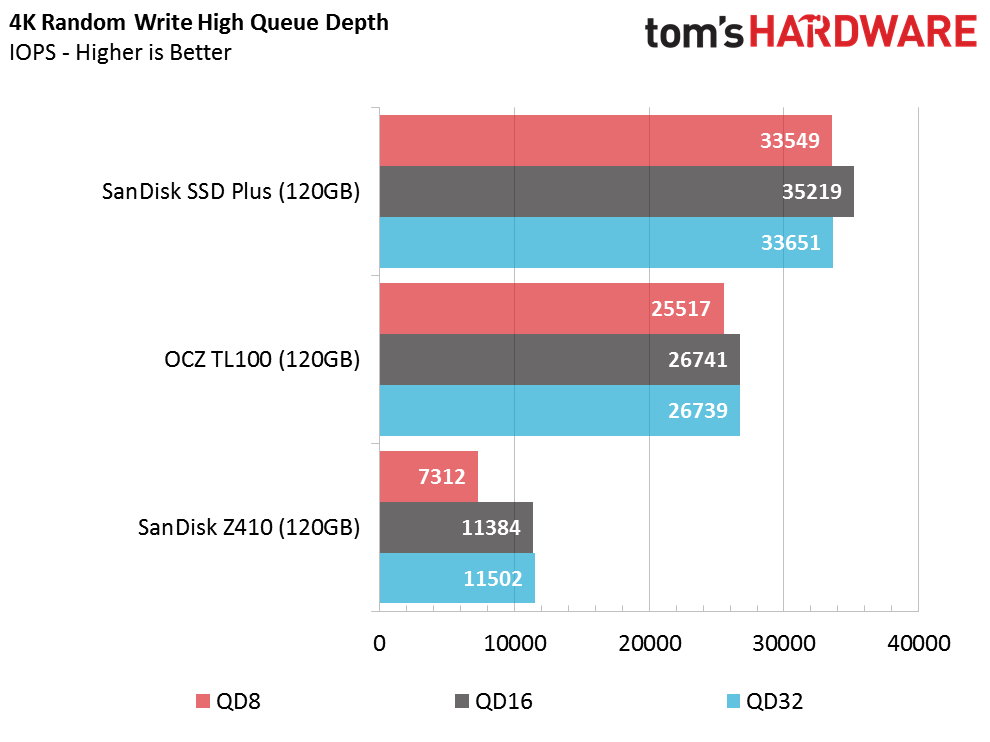

The random write performance tests came out exactly how we expected. The SSD Plus 120GB with MLC NAND walked away from the two TLC-based drives, but all of the results are equally unimpressive.
80 Percent Mixed Sequential Workload
We describe our mixed workload testing in detail here and describe our steady state tests here.
DRAMless SSDs deliver similar sequential mixed performance compared to TLC-based products. In this test, there really isn't that much difference compared to a DRAM-equipped product, like the Adata Ultimate SU800 we recently reviewed.
80 Percent Mixed Random Workload
Mixed random performance is much lower than a TLC-based drive with a DRAM cache. The benefits of increased random performance are difficult to quantify in words. When you transfer files at home, Windows delivers a pop up that says how fast the file transfers. This makes increased sequential performance easy to spot. Random performance is less obvious, but you can feel when a high-performance SSD is in a system.
Sequential Steady-State

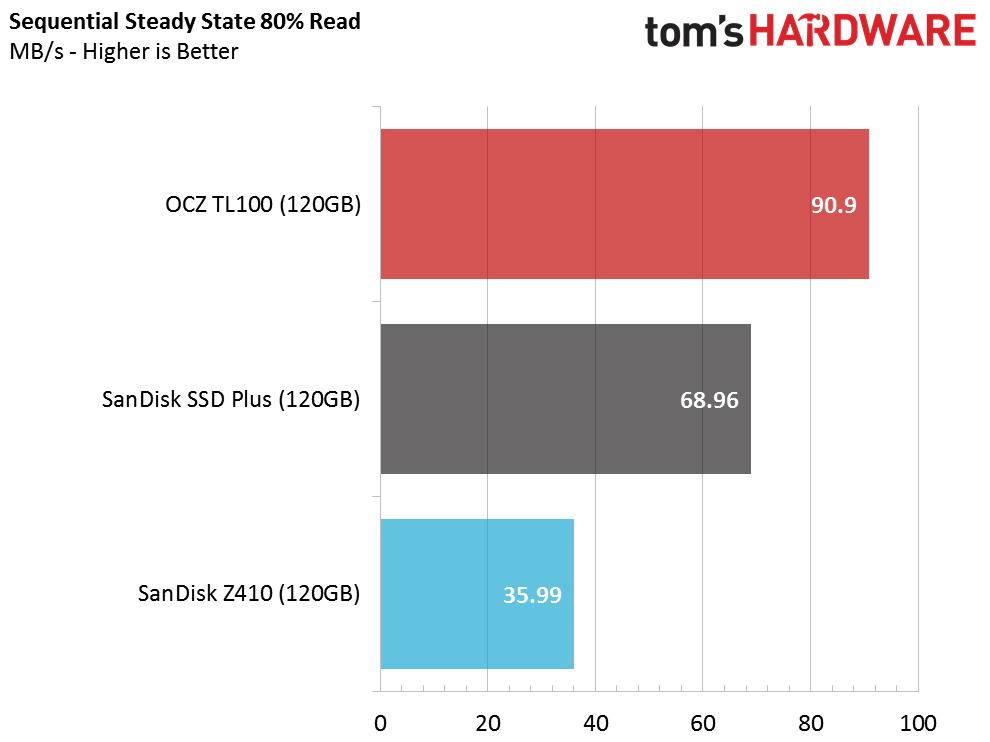

The SSD vendors didn’t design the three products in this chart for professional applications or heavy write environments. The test shows how low your sequential write performance can drop with a drive nearly full or during a heavy session of data writes.
Random Steady-State


The SanDisk Z410 is the only model with consistent performance. It delivers around 300 random read IOPS in steady-state (a measurement of worst-case performance). DRAMless SSDs are synonymous with "hard disk replacement," which is the term the SSD industry prefers. The three products deliver higher performance than an HDD, but you can't buy a 120GB hard drive, either.
PCMark 8 Real-World Software Performance
For details on our real-world software performance testing, please click here.



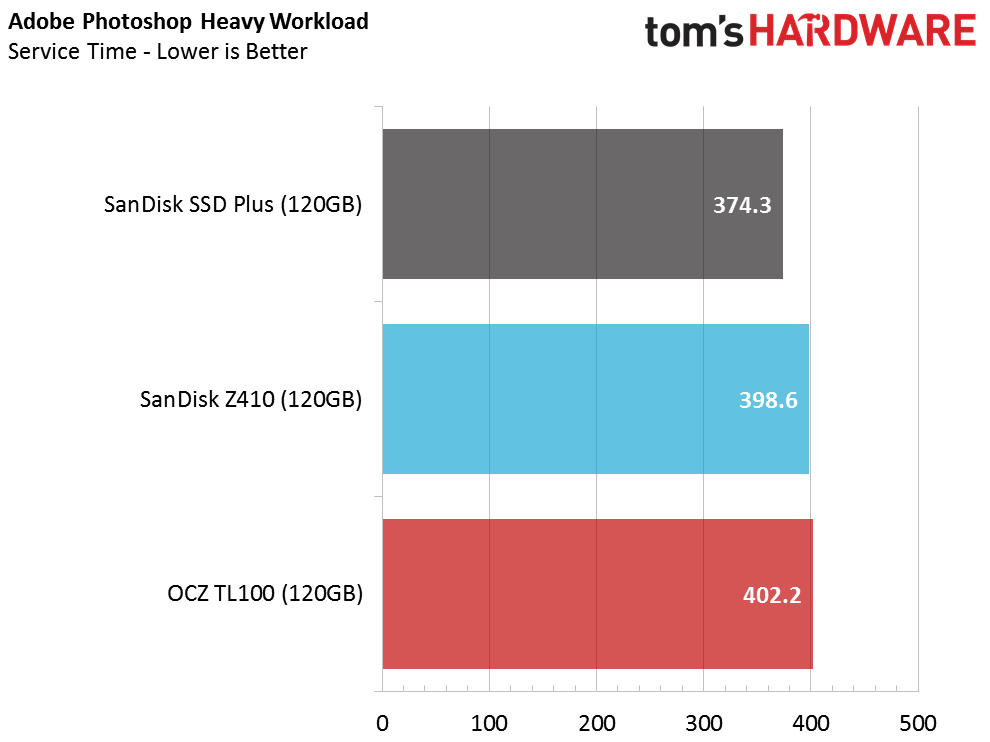

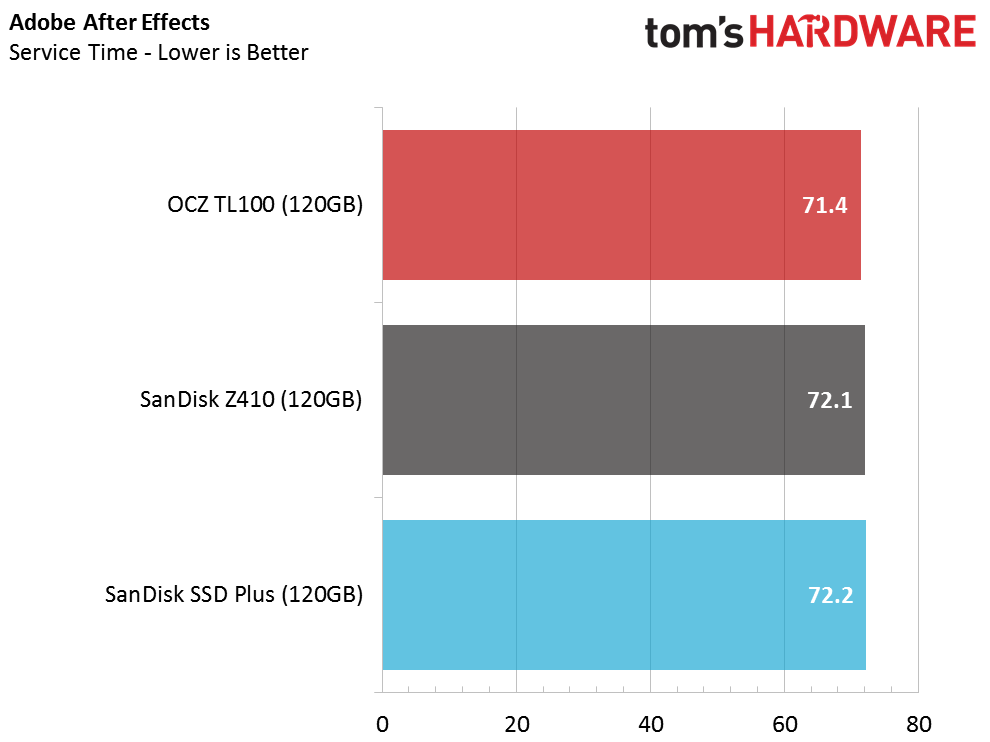

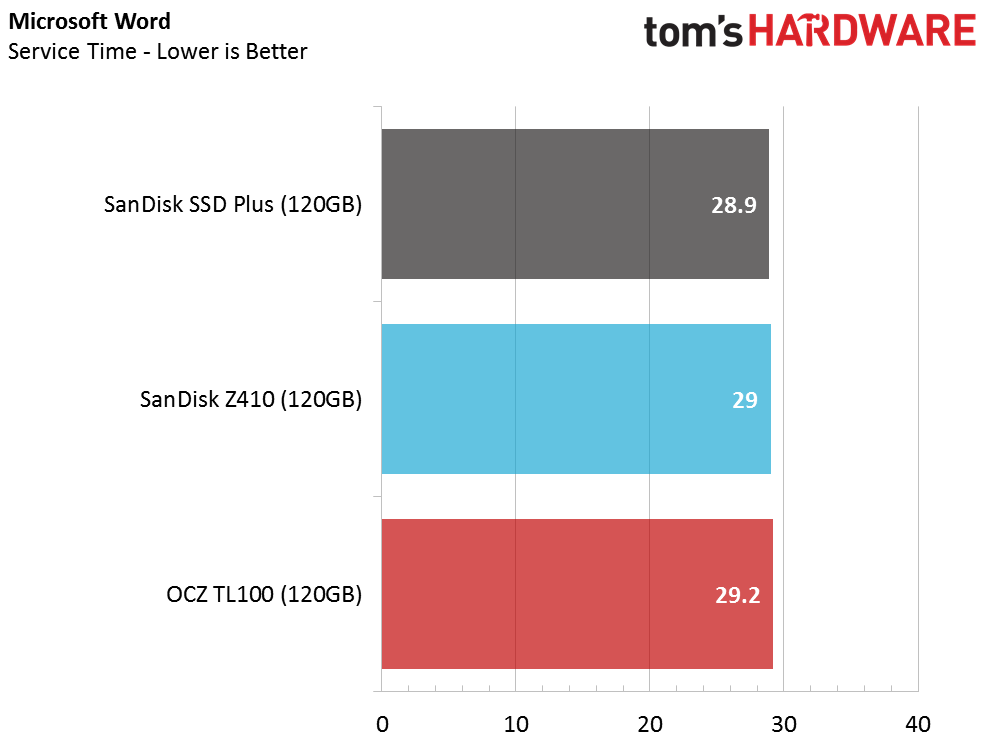


The three small capacity DRAMless SSDs take shots at the top of the performance list. The different controller and flash architectures lend a helping hand in some tests, but the configurations aren’t ideal for all consumer workloads.
Application Storage Bandwidth
The SanDisk SSD Plus with the SMI SM2246XT controller and Toshiba MLC flash outperforms the OCZ TL100 and SanDisk Z410 with TLC flash, but only by a small margin.
PCMark 8 Advanced Workload Performance
To learn how we test advanced workload performance, please click here.



Coming out of a heavy sustained workload, the MLC-powered SSD Plus recovers faster than the other products. The other two products recover, but at a much slower pace, and they fail to reach peak performance again during the trace-based test.
Total Service Time
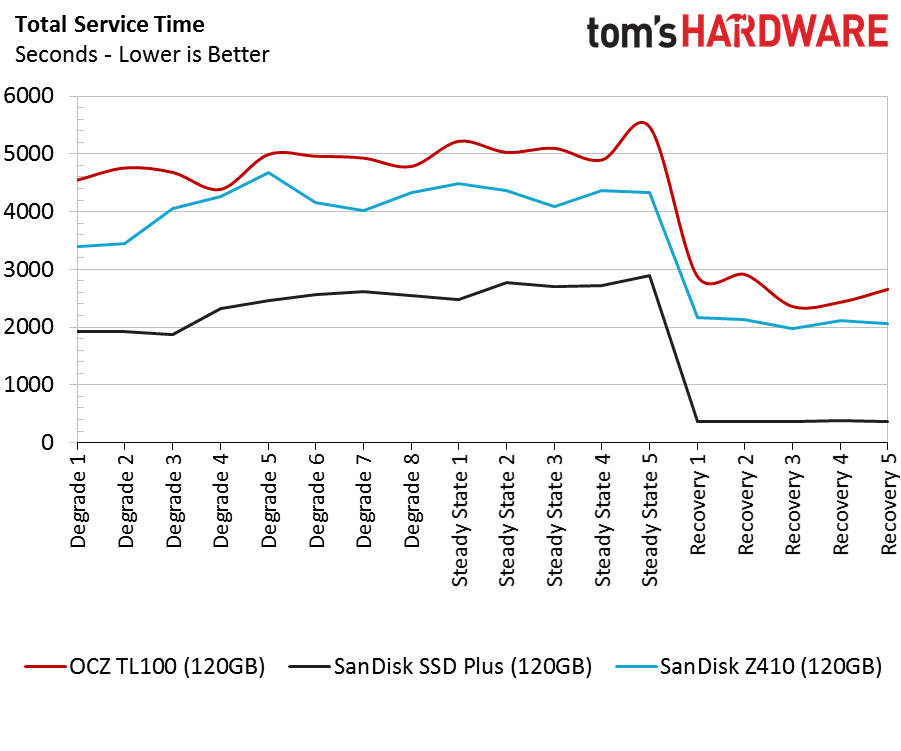


We expected the OCZ TL100 120GB to outperform the SanDisk Z410 120GB in this test, but that didn't happen. The SSD Plus 120GB with MLC flash completed the application tests much faster than the other products. To be very clear, the SSD Plus didn't deliver stellar performance. The SSD Plus wouldn't look as good in comparison with just about any modern DRAM-equipped SSD.
Notebook Battery Life


There is a very wide gap between the Z410 120GB, which has the longest battery life, and the OCZ TL100. The gap is roughly half an hour. It's difficult to imagine the large difference with so few components.
MORE: Best PC Builds
MORE: How To Build A PC
Current page: 128GB Benchmark Results
Prev Page Introduction & Overview Next Page 256GB Benchmark ResultsGet Tom's Hardware's best news and in-depth reviews, straight to your inbox.

Chris Ramseyer was a senior contributing editor for Tom's Hardware. He tested and reviewed consumer storage.
-
ponchato Look you guys need to get rid of this autoplaying, auto-resizing video or I'm done here. A tech website should not be this unusable. Skipping half a page down when I scroll slightly too far is incredibly annoying and you KNOW it irritates people and kills site usability. If it's not fixed or removed by this time next week (that's February 18th, 2017) I'm never coming to Tom's again.Reply -
MCMunroe I agree with ponchato. Every page has this big video that plays the same damn thing that is usually the biggest image on the screen. For months it was a smaller video of Doom that played over and over, and now is a big video of cherry keys. WTF.Reply
Can't you just tuck in normal ads? -
hixbot Agreed. And these click bait "from the web" ads are fake news scams at best and misogynistic and offensive at worst.Reply -
JimmiG I have a WD Green 240 GB SSD (DRAM less Marvell 88SS1074 and TLC) as a Steam games drive. It works fine for that purpose, since it's mostly sequential/random reads and very few writes (only when a game updates). No reason to not get one for that purpose, even as an "enthusiast". However, I wouldn't use them as system drives. I'm using a Samsung 850 Evo for that.Reply -
Mindrax Use uBlock or Adblock to prevent that.Reply
:)
I can't believe you don't already.
Internet is a horrible place without blockers. -
bit_user Gosh, I'm getting so paranoid about these ads that I wasn't even sure if theReply
Was this helpful?
Tom's needs your feedbackbanner was legit. Seems to be. -
bit_user Thanks for the tests, Chris (and the correction, Jon).Reply
Some of these SSD definitely need to come with a warning label!
-
jakjawagon You guys need to fix your UK website. Half the graphs are missing. Posting this here as well because it's more likely to be seen.Reply -
bit_user Reply
On some articles, with pages that have lots of graphs, occasionally not all of them load for me. I'd say try restarting your web browser or use a different one & see if that makes a difference.19284248 said:You guys need to fix your UK website. Half the graphs are missing. Posting this here as well because it's more likely to be seen. -
derekullo Firefox + Noscript + Adblock + Hosts file from www.winhelp2002.mvps.org/hosts.htmReply
Stop complaining and just block them.
I literally see 0 ads on Toms when I use the above with Firefox.
The host file i would say is the most important.
Even when I open Chrome 90% of the ads are gone, including the super annoying Doom video some guy was posting about yesterday. I literally had to go to another computer that didn't have the custom host file to see it. lol
I don't have adblock nor noscript with chrome so the hosts file alone is blocking those ads.





